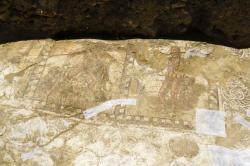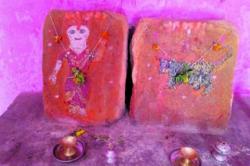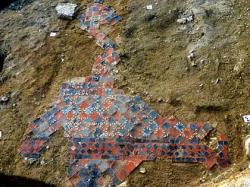INSTITUT SUPERIEUR D'ANTHROPOLOGIE
INSTITUTE OF ANTHROPOLOGY
ONLINE COURSES / COURS A DISTANCE
FALL TERM : OCTOBER 2016
REGISTER NOW
CHYPRE –  Larnaca - Only part of the mosaic, measuring 19 metres long and seven metres wide, has been excavated in the southern coastal city of Larnaca and officials believe more is still buried. "A preliminary estimation would suggest that scenes of the Labours of Hercules are depicted and that it is dated to the Roman period," the antiquities department said in a statement. The 12 most famous feats of Hercules are collectively known as the Labours of Hercules, and included slaying the Nemean Lion and killing the Lerna Hydra, or water snake. The antiquities department said the mosaic was evidence that Ancient Kition — on which modern Larnaca was built — played an important role in establishing Roman culture in Cyprus. "However, up to this day Roman remains found in the city are very few," the antiquities department said. "Therefore, the mosaic floor that came to light provides important evidence for the development of the city during the Roman period." Cyprus was under the control of the Roman Empire from 31 BC until the 4th century AD.
Larnaca - Only part of the mosaic, measuring 19 metres long and seven metres wide, has been excavated in the southern coastal city of Larnaca and officials believe more is still buried. "A preliminary estimation would suggest that scenes of the Labours of Hercules are depicted and that it is dated to the Roman period," the antiquities department said in a statement. The 12 most famous feats of Hercules are collectively known as the Labours of Hercules, and included slaying the Nemean Lion and killing the Lerna Hydra, or water snake. The antiquities department said the mosaic was evidence that Ancient Kition — on which modern Larnaca was built — played an important role in establishing Roman culture in Cyprus. "However, up to this day Roman remains found in the city are very few," the antiquities department said. "Therefore, the mosaic floor that came to light provides important evidence for the development of the city during the Roman period." Cyprus was under the control of the Roman Empire from 31 BC until the 4th century AD.
http://www.abc.net.au/news/2016-07-15/rare-roman-mosaic-uncovered-in-cyprus/7631368
INDE –  Mumbai - As the battle between environmentalists and the Mumbai Metropolitan Region Development Authority (MMRDA) rages on over construction activities in the city’s green lungs, recent archaeological findings have thrown light on the rich heritage that lies buried beneath Aarey Colony. Experts from Mumbai University (MU) have stumbled upon sculptures and artefacts inside the colony, including some dating back to the Shilahara dynasty (c. 765 to 1029 AD). Archaeologists from MU’s Centre of Archaeology and the Centre for Extra-Mural Studies (CEMS) on Saturday released their findings on artefacts and scattered individual traces of the Shilahara, Yadava, Pre-Portuguese and Post-Portuguese eras that were unearthed across Mumbai precinct. As Mahim and Marol were Shilahara capitals, the researchers, who started their work earlier this year, have focused on these regions. Vinayak Parab, who spearheaded the work at Aarey Colony — which is near the Shilahara’s economic capital in Marol, mentioned that his team has learnt of the colony’s rich cultural heritage. “In the Malhar Koli settlements of Ultan Pada, we found the remains of statues of Kuladevata (community goddesses). At the same time, various sculptures of gaodevis (village goddesses) were found near the banks of Vihar lake, Choitacha Pada, Mataipada and Keltipada (a hillock that is a famous picnic spot). There was a beautiful sculpture of Charandev, a local deity, in Charandev Pada and Waghoba in Maroshipada. All these sculptures, traces of household items and scattered evidence were found near the Shilahara capital Marol, indicating that with deeper research we could learn more about the archaeological evidence hidden inside Aarey Colony,” said Mr Parab. Experts also said that a large section of temple pillars dating back to the Shilahara dynasty were found near the old Aarey Colony tollbooth. He said that they need time to excavate further and locate more evidence in order to unearth prehistoric material.
Mumbai - As the battle between environmentalists and the Mumbai Metropolitan Region Development Authority (MMRDA) rages on over construction activities in the city’s green lungs, recent archaeological findings have thrown light on the rich heritage that lies buried beneath Aarey Colony. Experts from Mumbai University (MU) have stumbled upon sculptures and artefacts inside the colony, including some dating back to the Shilahara dynasty (c. 765 to 1029 AD). Archaeologists from MU’s Centre of Archaeology and the Centre for Extra-Mural Studies (CEMS) on Saturday released their findings on artefacts and scattered individual traces of the Shilahara, Yadava, Pre-Portuguese and Post-Portuguese eras that were unearthed across Mumbai precinct. As Mahim and Marol were Shilahara capitals, the researchers, who started their work earlier this year, have focused on these regions. Vinayak Parab, who spearheaded the work at Aarey Colony — which is near the Shilahara’s economic capital in Marol, mentioned that his team has learnt of the colony’s rich cultural heritage. “In the Malhar Koli settlements of Ultan Pada, we found the remains of statues of Kuladevata (community goddesses). At the same time, various sculptures of gaodevis (village goddesses) were found near the banks of Vihar lake, Choitacha Pada, Mataipada and Keltipada (a hillock that is a famous picnic spot). There was a beautiful sculpture of Charandev, a local deity, in Charandev Pada and Waghoba in Maroshipada. All these sculptures, traces of household items and scattered evidence were found near the Shilahara capital Marol, indicating that with deeper research we could learn more about the archaeological evidence hidden inside Aarey Colony,” said Mr Parab. Experts also said that a large section of temple pillars dating back to the Shilahara dynasty were found near the old Aarey Colony tollbooth. He said that they need time to excavate further and locate more evidence in order to unearth prehistoric material.
http://www.asianage.com/mumbai/ancient-artefacts-unearthed-aarey-colony-632
INDE – Mumbai - Mumbai's construction industry's frenzied excavation activity has unravelled a spectacular 40-feet columnar joint structure of trachyte rock. The columnar wall, 200 feet wide, was discovered while excavating the Bandongri hill at Malad East for the construction of a basement of an upcoming residential tower. Trachyte rocks form the facade of the city's famous neo-Gothic heritage monuments such as the CST station, Rajabai Tower, the BMC headquarters, the Esplanade court and several other buildings in Fort.
http://timesofindia.indiatimes.com/city/mumbai/Column-of-rock-used-to-build-SoBo-landmarks-unearthed-during-building-work/articleshow/53233294.cms
ROYAUME UNI –  Aberlady - Archaeologists have unearthed evidence of what is believed to be the largest Anglo-Saxon building found in Scotland. The foundations of the building, which may have been a monastery or even a royal home dating back to about 1,200 years ago, were discovered during excavations in Glebe Field, Aberlady. Tests on an animal bone found at the scene have confirmed it dates back to between the 7th and 9th century. The result of radiocarbon-dating the bone confirms the foundations for the building, which would have measured 40 metres by 20 metres, is from Anglo-Saxon times. The dig, which took place in April and May, was overseen by AOC Archaeology Group and the society with the help of the local community. It aimed to discover the remains of Anglo-Saxon timber halls, after the largest concentration of Anglo-Saxon metal objects to be found in Scotland were discovered in the field. Aberlady was on a pilgrimage route between Iona and Holy Island and a fragment of an eighth-century cross was also discovered. The dig unearthed evidence of a large structure, with the stone foundation of a wall along its short end. Mr Malcolm said the structure would have to be significant because of the work that would have been undertaken to build it. He said: “It may have been monastic, or a feast hall or a royal site. There have been other excavations but no evidence of a structure on this scale has been discovered.”
Aberlady - Archaeologists have unearthed evidence of what is believed to be the largest Anglo-Saxon building found in Scotland. The foundations of the building, which may have been a monastery or even a royal home dating back to about 1,200 years ago, were discovered during excavations in Glebe Field, Aberlady. Tests on an animal bone found at the scene have confirmed it dates back to between the 7th and 9th century. The result of radiocarbon-dating the bone confirms the foundations for the building, which would have measured 40 metres by 20 metres, is from Anglo-Saxon times. The dig, which took place in April and May, was overseen by AOC Archaeology Group and the society with the help of the local community. It aimed to discover the remains of Anglo-Saxon timber halls, after the largest concentration of Anglo-Saxon metal objects to be found in Scotland were discovered in the field. Aberlady was on a pilgrimage route between Iona and Holy Island and a fragment of an eighth-century cross was also discovered. The dig unearthed evidence of a large structure, with the stone foundation of a wall along its short end. Mr Malcolm said the structure would have to be significant because of the work that would have been undertaken to build it. He said: “It may have been monastic, or a feast hall or a royal site. There have been other excavations but no evidence of a structure on this scale has been discovered.”
http://www.eastlothiancourier.com/news/14620182.Archaeologists_find_evidence_of___39_largest_Anglo_Saxon_building_in_Scotland__39__in_East_Lothian/
ROYAUME UNI –  Oxford - Only surviving section of medieval decorated tiled floor that we had found since the dig began 13 months previously on the Westgate Oxford site .It wasn’t large, but we estimated 350-plus tiles or so, and the hint of an interesting pattern through the roughly brushed surface. The survey also showed us that the surface formed the south east corner of the cloister walk pavement - a walkway which would have run around the entire main cloister. bThe main cloister was formed of a central open area (probably grassed), surrounded by a covered walkway - the cloister walk. This connected the most important buildings in the friary; the church (to the north), the sacristy and chapter house (usually in the east range), and the lodgings and libraries (in the south and west ranges). The tiles were probably made near Newbury in West Berkshire and are of the 'Stabbed Wessex' type, whose main period of use was between AD 1280 – 1350. These were probably laid in the 1240’s-50’s when the friary was constructed. The larger tiles are about 15cm square and 3cm thick and have very deeply-inlaid white slip patterns including daisies, fleur-de-lys and curved-sided 4-pointed ‘stars’. The reverse is characterised by ‘stabbing’ of the wet clay during manufacture, these indents help to keep them mortared into place.
Oxford - Only surviving section of medieval decorated tiled floor that we had found since the dig began 13 months previously on the Westgate Oxford site .It wasn’t large, but we estimated 350-plus tiles or so, and the hint of an interesting pattern through the roughly brushed surface. The survey also showed us that the surface formed the south east corner of the cloister walk pavement - a walkway which would have run around the entire main cloister. bThe main cloister was formed of a central open area (probably grassed), surrounded by a covered walkway - the cloister walk. This connected the most important buildings in the friary; the church (to the north), the sacristy and chapter house (usually in the east range), and the lodgings and libraries (in the south and west ranges). The tiles were probably made near Newbury in West Berkshire and are of the 'Stabbed Wessex' type, whose main period of use was between AD 1280 – 1350. These were probably laid in the 1240’s-50’s when the friary was constructed. The larger tiles are about 15cm square and 3cm thick and have very deeply-inlaid white slip patterns including daisies, fleur-de-lys and curved-sided 4-pointed ‘stars’. The reverse is characterised by ‘stabbing’ of the wet clay during manufacture, these indents help to keep them mortared into place.
http://www.culture24.org.uk/history-and-heritage/archaeology/art558663-You-always-find-the-best-stuff-on-the-last-day-Unearthing-a-medieval-tile-floor-at-Westgate-Oxford